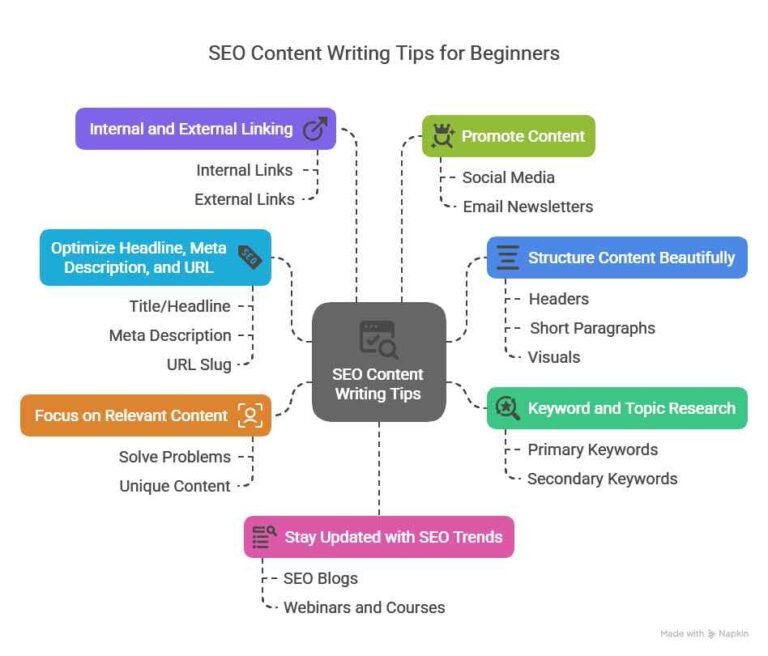Your First Step Toward SEO Content Mastery

Imagine writing a wonderful piece, pouring your heart into it, but hardly anyone finds it online. Frustrating, right?
That’s where SEO content writing comes in. It’s not just about writing beautifully; it’s about writing strategically so both people and search engines love your work.
In the last blog post, I discussed how to discover writer’s voice and what is it? Read it to understand the todays topic more deeply.
Today, we’re diving into SEO content writing tips for beginners — designed to help you create high-ranking, authentic, and engaging content, even if you’re just starting out. Plus, we’ll sprinkle in answers to burning questions like “What are the hard and fast rules of content writing?” and “What every writer should know?”
Ready? Let’s jump in!
What is SEO Content Writing, Anyway?
At its core, SEO content writing means creating articles, blog posts, or web pages that are search engine friendly without forgetting the reader’s heart.
It’s like cooking a delicious meal but also making sure it looks so good that everyone wants a bite (including Google)!
✅ Write naturally for humans.
✅ Smartly optimize for search engines using keywords and structure.
That balance is the secret sauce to make your content visible and valuable.
Why Does SEO Writing Matter So Much for Visibility?
You could have the most brilliant content, but without SEO, it’s like a hidden treasure that nobody knows exists.
Good SEO writing:
- Pushes your content higher on Google and other search engines.
- Brings organic (free!) traffic without spending a dime on ads.
- Builds trust and authority in your niche over time.
- Helps readers find exactly what they need — and fast!

It’s not magic; it’s smart strategy mixed with consistent effort.
Remember: Paid ads stop working when your budget dries up.
SEO content keeps giving forever! 🎯
Essential SEO Content Writing Tips for Beginners
Let’s now get practical!
Here’s your beginner-friendly roadmap to writing SEO content that ranks and resonates.

Conduct Smart Keyword and Topic Research
Before you write a single word, know what people are searching for.
✅ Primary Keywords: Your main topic (example: SEO content writing).
✅ Secondary Keywords: Related phrases that support your topic (example: SEO tips for writers, on-page SEO basics).
Tools to help you:
- Google Keyword Planner
- SEMrush
- Ahrefs
- Ubersuggest
- Google Trends (to spot what’s hot)
🎯 Pro Tip: Always think while doing keyword research: What questions are people asking? What answers can I give?
(Search Intent = Your best friend!)
Optimize Your Headline, Meta Description, and URL
First impressions matter — not just for people, but for Google too!
- Title/Headline:
Include your main keyword naturally. Keep it under 60 characters.
Example: SEO Content Writing Tips That Rank in 2025! - Meta Description:
This is the short text users see under your title on search engines.
Make it clear, catchy, and keyword-rich (under 155 characters).
✅ Example Meta Description:
“Master SEO content writing with beginner tips that boost traffic, rank higher, and engage your audience. Start today!”
- URL Slug:
Short, simple, and keyword-focused.
✅ Example: yourwebsite.com/seo-writing-tips
Focus Deeply on Relevant Content & Search Intent
Ask yourself:
“What exactly is the user trying to find?”
If someone types “SEO content writing tips for beginners,” they probably want practical, step-by-step guidance — not boring theory.
Your content should:
- Solve their problem immediately.
- Be fresh, unique, and helpful.
- Speak to them like a real person, not a robot.
Never write for algorithms alone.
Write for the human on the other side of the screen. 💬
Structure Your Content Beautifully
Good structure = Happy readers = Higher SEO rankings!
✅ Use Headers (H1, H2, H3): Help readers skim and search engines understand your topic better.
✅ Short Paragraphs: Keep them under 3–4 lines.
✅ Bullet Points & Numbered Lists: Make information snackable.
✅ Images and Visuals: Break the monotony with pictures, infographics, or GIFs.
✅ Readable Language:
Use tools like Hemingway App or Grammarly to ensure clarity.
And remember, one of the golden SEO content rules is:
“If in doubt, simplify!”
Internal and External Linking = Your Secret SEO Superpower
- Internal Links: Link to your own related articles or pages.
(Example: While learning about SEO writing, you may also love our guide on Keyword Research 101!) - External Links: Link out to credible sources like Moz, HubSpot, or Google’s official blogs.
But here’s the catch:
✅ Link naturally.
✅ Use descriptive anchor text.
(Instead of “click here,” say “discover the best SEO writing practices.”)
Promote Your Content Like a Pro
Writing awesome SEO content is half the battle.
Promotion is the other half!
✅ Share on your social media (LinkedIn, X, Instagram, Facebook).
✅ Send it out via email newsletters.
✅ Collaborate with others (guest blogging, partnerships).
✅ Add social sharing buttons to your blog.
More eyeballs = More traffic = More SEO authority!
Stay Updated with SEO Trends
SEO isn’t set in stone. It evolves.
(Just like fashion — what worked yesterday might flop tomorrow!)
✅ Follow SEO blogs like Moz, Neil Patel, and Backlinko.
✅ Attend webinars, courses, and conferences.
✅ Keep experimenting and tweaking based on what works.
Pro SEO Tip:
Test. Analyze. Adapt. Win! 🎯
What Every Writer Should Know About Content Writing Rules
Before we wrap up, here’s a quick pit stop to answer some common beginner questions — in simple English.

What Are the Hard and Fast Rules of Content Writing?
✅ Always write for the reader first.
✅ Maintain clarity and simplicity.
✅ Stick to correct grammar and spelling.
✅ Stay relevant to the topic.
✅ Edit, polish, and proofread!
What Is the Golden Rule of Content Writing?
Write with the reader in mind, and the rest will follow.
Whether you’re telling a story, giving advice, or explaining a concept — make it easy, useful, and engaging.
What Are the 4 Cs of Content Writing?
The famous 4 Cs are:
- Clear: Say it simply.
- Concise: Cut the fluff.
- Compelling: Hook readers emotionally.
- Credible: Back up claims with evidence.
What Are the Basic Rules of Grammar?
The 12 rules of basic grammar include:
- Use correct subject-verb agreement.
- Keep tenses consistent.
- Capitalize proper nouns.
- Use punctuation correctly (especially commas and periods!).
- Maintain logical sentence structure.
(Grammar isn’t boring — it’s your writing’s backbone!)
What Is the Basic Guideline for Writing?
One line:
“Plan, Write, Edit, Improve.”
Think clearly, write freely, edit ruthlessly, and polish beautifully!
What Are the Four Rules of Effective Writing?
- Be clear.
- Be concise.
- Be relevant.
- Be consistent.
Stick to these, and you’re golden!
Conclusion: Your SEO Content Writing Journey Starts Now!
Phew! That was quite a ride, wasn’t it?
But guess what?
You’re now equipped with solid SEO content writing basics to not just survive but thrive as a freelance writer, blogger, or content creator.
Remember:
- Focus on humans first.
- Optimize smartly for SEO.
- Keep learning and evolving.
If you follow these tips, you’ll soon find your work climbing up Google’s rankings, bringing organic traffic, engagement, and success your way.
So, take a deep breath, open a new doc, and start writing your first SEO-optimized masterpiece today! 🚀
FAQs for Quick SEO Content Writing Guide
It’s the process of planning, writing, and editing web content to attract, inform, and engage an audience.
Always prioritize clarity — make sure your message is understood easily.
Practice keyword research, understand search intent, structure articles well, and keep learning SEO trends.
Yes! SEO writing balances quality content with search engine optimization to boost visibility and rankings.
Ideally, stay updated monthly since SEO best practices evolve quickly.







I simply could not go away your web site prior to suggesting that I really enjoyed the standard info a person supply on your guests Is going to be back incessantly to investigate crosscheck new posts